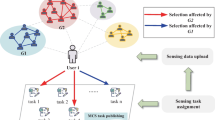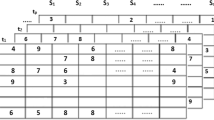Abstract
For service behavior prediction, if merely depending on behavior history of a target user, the quantity and category of samples are quite limited; if utilizing correlated users’ samples by means of result fusion, the predicted results are very likely to be interfered by noise samples. Therefore, based on the mobile social environment (MSE) of a target user in this paper, the correlated user with the closest long-term habits and that with the greatest short-term influences for the target user are respectively obtained by using optimization theory. Their behavior samples are integrated into the sample database of target user to construct a sample enriched mechanism with minimized noise for improving the accuracy of user behavior prediction remarkably. First, according to the characteristics of MSE, two optimization models based on similarity degree and interaction degree respectively are formulated to select the corresponding optimal correlated users for analyzing two main factors of the target user’s behaviors; furthermore, an adaptive update strategy based on fuzzy theory is proposed to describe the importance of two factors in real time and quantitative manners. Second, an improved Apriori theory is introduced to predict user next service behaviors accurately; particularly, a new update mechanism of Apriori sample database is constructed to effectively integrate the samples of optimal correlated users. Finally, extensive simulation results show that the proposed algorithm outperforms several related algorithms in terms of prediction accuracy and operation efficiency.







Similar content being viewed by others
References
Yang, K., Cheng, X., Hu, L., & Zhang, J. (2012). Mobile social networks: State-of-the-art and a new vision. International Journal of Communication Systems, 25(10), 1245–1259.
Chan, S. Y., Hui, P., & Xu, K. (2009). Community detection of time-varying mobile social networks. Lecture Notes of the Institute for Computer Sciences, Social Informatics and Telecommunications Engineering, 4, 1154–1159.
Mao, Y., Wang, J. Y., & Sheng, B. (2016). Mobile message board: Location-based message dissemination in wireless ad hoc networks. In 2016 international conference on computing, networking and communications (ICNC), pp. 1–5.
Liang, L., Bin, C., Bo, Q., et al. (2017). Data driven modeling of continuous time information diffusion in social networks. In 2017 IEEE second international conference on data science in cyberspace, pp. 655–660.
Narges, R. M., Mehrdad, J., & Majid, V. J. (2015). Inference of mobile users’ social relationships using bayesian belief network. In 2015 international congress on technology, communication and knowledge, pp. 232–240.
Awad, M. A., & Khalil, I. (2012). Prediction of user’s web-browsing behavior: Application of Markov model. IEEE Transactions on Systems, Man, and Cybernetics, 42(4), 1131–1142.
Nagalakshmi, S., & Sumathi, R. (2014). An efficient mobile commerce explorer for mobile user’s behavior pattern mining and prediction. In IEEE international conference on information communication and embedded systems (ICICES), pp. 1–7.
Kim, Y. J., & Cho, S. B. (2009). A recommendation agent for mobile phone users using Bayesian behavior prediction. In IEEE third international conference on mobile ubiquitous computer, systems, services and technologies, pp. 1–6.
Serban, G., Tarta, A., & Moldovan, G. S. (2007). A learning interface agent for user behavior prediction. In J. Jacko (Ed.), Human–computer interaction, LNCS (pp. 508–517). Berlin, Heidelberg: Springer.
Song, Y., Hu, Z., Leng, X. M., & Tian, H. (2015). Friendship influence on mobile behavior of location based social networks users. Journal of Communications and Networks, 17(2), 126–132.
Pang, Y. J., & Du, S. Y. (2014). Research on the selecting mechanism of individual interactive object for online social network. In 2014 IEEE/ACM international conference on advances in social networks analysis and mining, pp. 820–827.
Boutsis, I., Karanikolaou, S., & Kalogeraki, V. (2015). Personalized event recommendations using social networks. In 2015 16th IEEE international conference on mobile data management (MDM), pp. 84–93.
Bo, H., Jamali, M., & Ester, M. (2012). Learning the strength of the factors influencing user behavior in online social networks. In 2012 IEEE/ACM international conference on advances in social networks analysis and mining (ASONAM), pp. 368–375.
Guo, M., & Shang, L. (2013). Selecting the appropriate fuzzy membership functions based on user-demand in fuzzy decision-theoretic rough set model. In IEEE international conference on fuzzy systems (FUZZ), pp. 1–8.
Meng, J. L., & Zhang, N. (2013). Research on the user behavior analysis based on improved Apriori. In IEEE international conference on mechatronic sciences electric engineering and computer (MEC), pp. 1812–1815.
Wang, F., & Li, Y. H. (2008). An improved Apriori algorithm based on the matrix. In 2008 international seminar on future biomedical information engineering, pp. 152–155.
User behavior data set. (2012). http://www.datatang.com/data/42989.
Cacciapuoti, A. S., Calabrese, F., Caleffi, M., Di Lorenzo, G., & Paura, L. (2012). Human-mobility enabled networks in urban environments: Is there any (mobile wireless) small world out there? Ad Hoc Networks, 10(8), 1520–1531.
Acknowledgements
This work is supported by National Natural Science Foundation of China (61471203); Six Talent Peaks Project of Jiangsu Province (RJFW-024); “Qing Lan Project” of Jiangsu Province (2016); “1311 Talent Program” of NJUPT (2015); Open Project of National Engineering Research Center of Communications and Networking (TXKY17002); Open Project of Jiangsu Provincial Key Laboratory for Computer Information Processing Technology (KJS1518); National Science and Technology Major Projects (2012ZX03001008-003); Priority Academic Program Development of Jiangsu Higher Education Institutions — Information and Communication Engineering.
Author information
Authors and Affiliations
Corresponding author
Rights and permissions
About this article
Cite this article
Zhang, H., Wang, M., Yang, L. et al. A novel user behavior analysis and prediction algorithm based on mobile social environment. Wireless Netw 25, 791–803 (2019). https://doi.org/10.1007/s11276-017-1592-0
Published:
Issue Date:
DOI: https://doi.org/10.1007/s11276-017-1592-0




